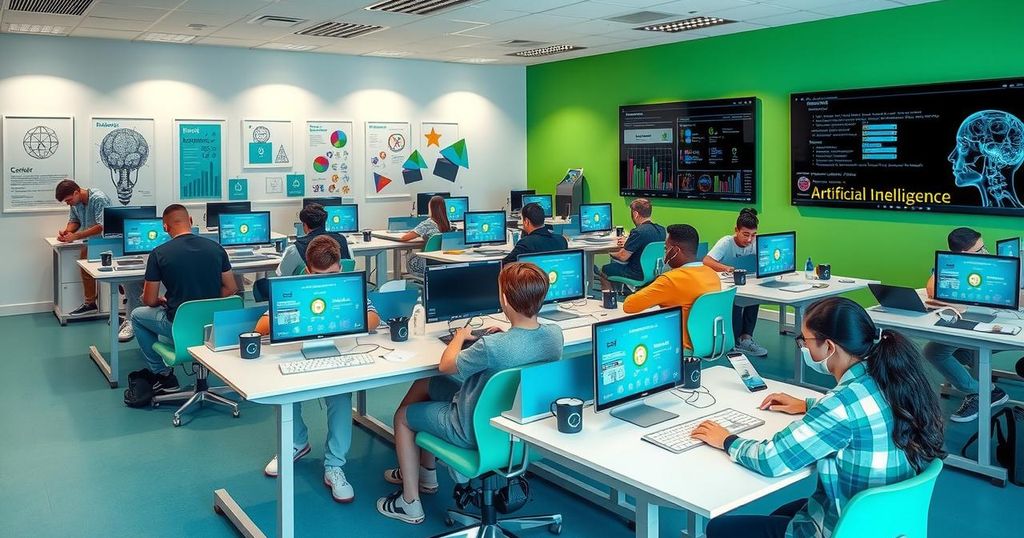AI
Tech
ART, ARTIFICIAL INTELLIGENCE, EXHIBITION, EXHIBITIONS, GOLIS, GOLISANO INSTITUTE FOR BUSINESS & ENTREPRENEURSHIP, IAN MORTIMER, MATT PASSANTINO, MENTAL HEALTH, MONA SEGHATOLESLAMI, NEW VISION DEVELOPMENT GROUP, NORTH AMERICA, PATTI LUPONE, ROCHESTER, ROCHESTER INSTITUTE OF TECHNOLOGY, TECHNOLOGY, UNITED STATES, WXXI CLASSICAL 91, WXXI CLASSICAL 91. 5 FM
James O'Connor
0 Comments
AI Integration in Education and the Ethical Dilemma of Artists
Artificial intelligence is now a staple in higher education, notably at the Golisano Institute where AI-focused coursework is on the rise. Students are left to ponder the consequences of not engaging with AI in their education as the job market demands new skills. Meanwhile, in the realm of theater, Patti LuPone’s controversial comments reveal tensions between admiration for an artist’s work and their actions, sparking discussion on the ethics of art consumption.
A landscape once quiet about artificial intelligence is now buzzing. Just five years ago, AI barely made a whisper on higher education campuses. Fast forward to today, and it’s not just an afterthought; it’s woven into the very fabric of educational practices. At the Golisano Institute for Business & Entrepreneurship in Rochester, for example, students now engage with 12 credits focused on coding, analytics, and AI. Making waves, the institute is gearing up to unveil a new AI and Business program, highlighting an urgent need for AI-savvy graduates in a shifting job market.
Students pondering whether to embrace AI or take a backseat might need to think again. Ian Mortimer, president of Golisano Institute, reflects on the gravity of this decision for students like Max Post—the latter is juggling classes and his reality as an AI engineer for New Vision Development Group. As job landscapes evolve rapidly, the looming question remains: will students resisting AI risk being left behind?
Shifting gears now, we enter the world of theater, where Patti LuPone, a three-time Tony Award winner, stirred quite a pot with her candid comments in a recent New Yorker interview. Fans are finding themselves in a bit of a quandary. They adore her performances but grapple with a degree of discomfort regarding her remarks. How do consumers of art make sense of such contradictions within the creator-consumer relationship?
In this ripe discussion, we turn to experts like Mona Seghatoleslami, the music director at WXXI Classical 91.5 FM, who brings insights from the realm of music. Film critic Matt Passantino from CITY Magazine adds his voice, expanding on how context shapes our viewing experiences.
And then, Thomas Warfield—a professor of practice at the National Technical Institute for the Deaf—chimes in with his perspective on how performing arts intersect with these conversations. Is there a real distinction in how we judge the work of living artists versus those who’ve long since departed?
Disentangling the artist from their work presents a tricky path to trot. It’s about examining the complexities of our relationship with art. Perhaps there are no clear lines, just a spectrum of personal interpretations and feelings. As we navigate this ever-changing narrative in both AI education and artistic appreciation, one thing is glaringly clear: the conversation is just getting started.
The integration of AI into the curriculum across higher education marks a pivotal shift in how students prepare for their futures. The urgency of acquiring AI skills is paramount for staying relevant in an evolving job market, as highlighted by the developments at the Golisano Institute. On a parallel note, the dialogue sparked by Patti LuPone’s recent remarks raises deeper questions about our relationship with artists. Balancing art with its creators’ actions remains a complex territory, indicating that consumers will continue navigating these waters as they evolve.
Original Source: www.wxxinews.org




Post Comment